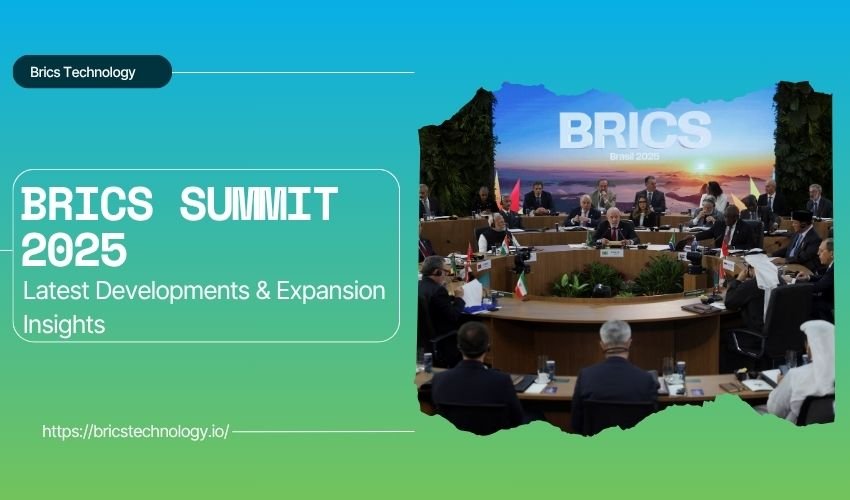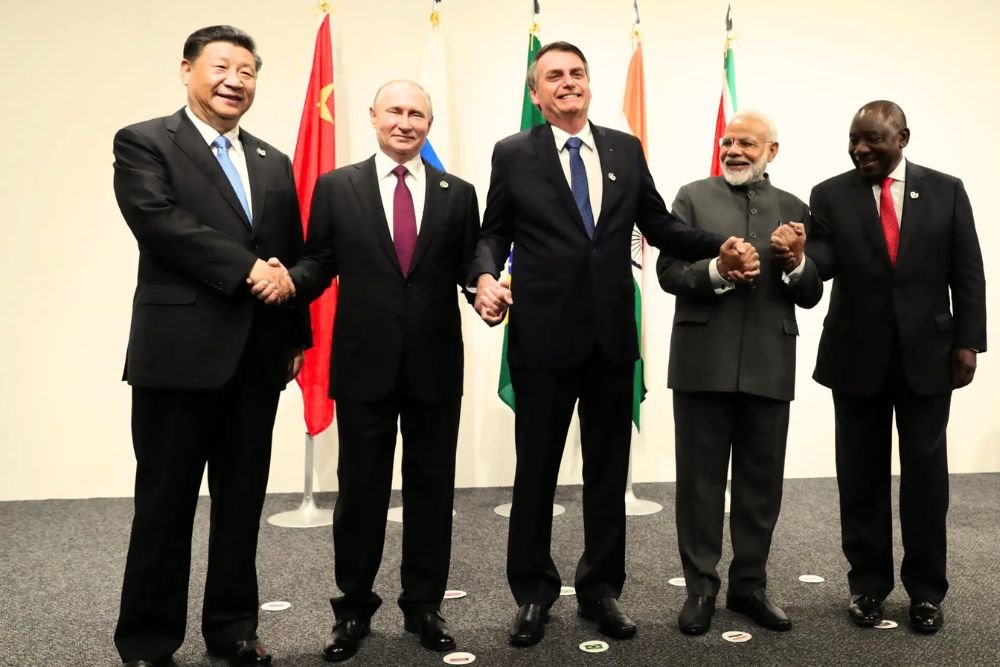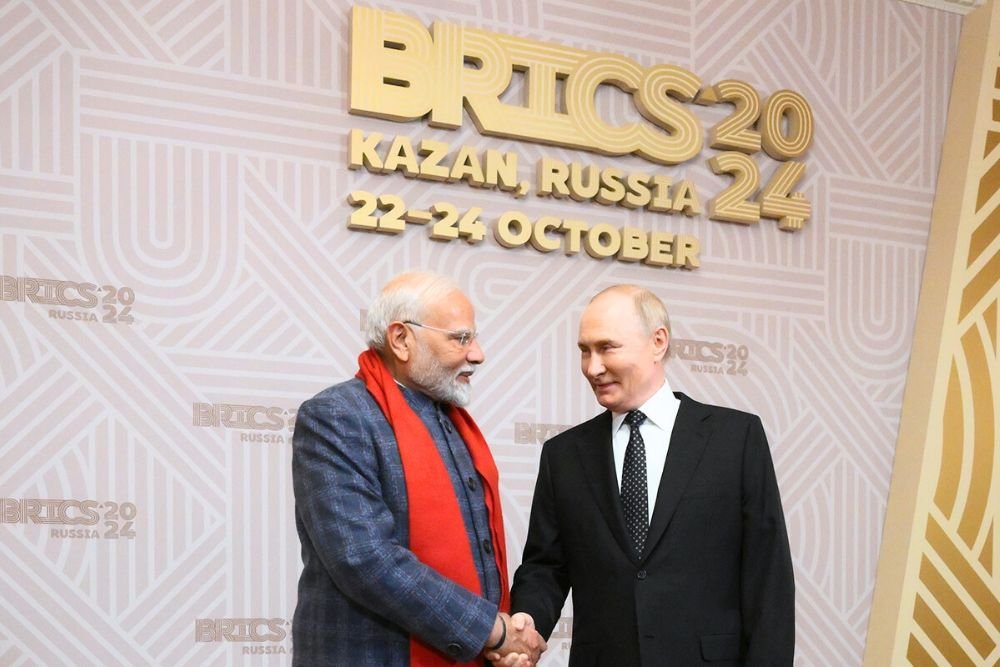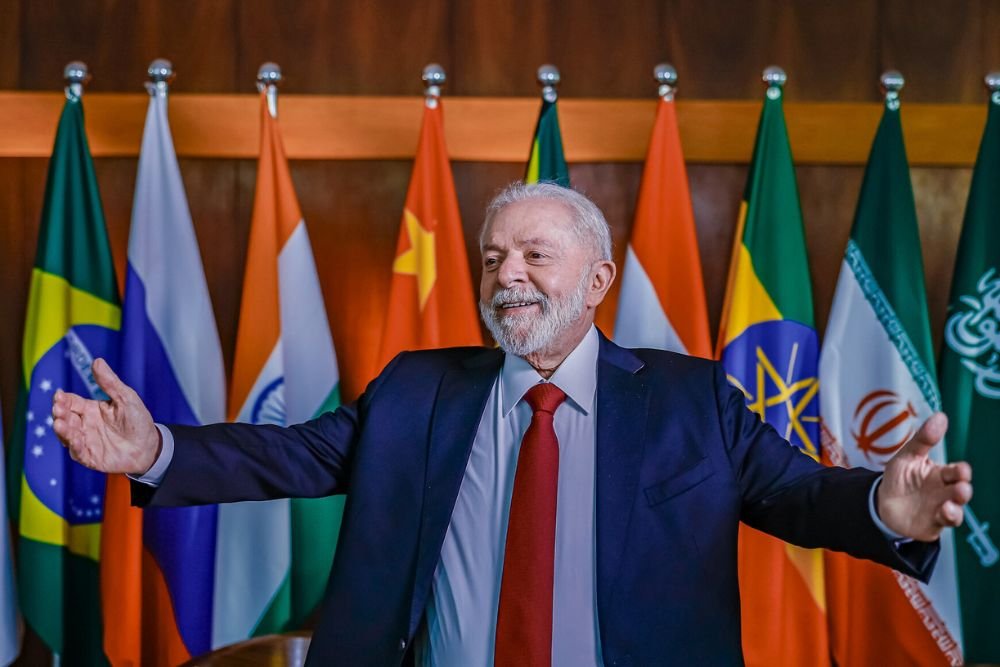BRICS Summit 2025: Latest Developments & Expansion Insights

What if the next big shift in global power does not come from Washington or Brussels, but from Rio?
Brazil will host the 17th BRICS Summit in July 2025. An expanded alliance of 11 BRICS nations and nine partners is expected to further challenge Western economic dominance in Rio.
What to keep an eye on? It is the expected new BRICS currency. BRICS is not just talking about change anymore. They are also actively building new payment systems and aim to challenge the dollar’s hold on global trade.
BRICS started in 2009 as a hopeful coalition of rising economies. But now, with members like Saudi Arabia, Iran, and Egypt on board, it has evolved into a bloc representing over 40% of the global population and a significant part of global GDP.
The 16th BRICS Summit 2024 in Kazan was a turning point. The following hot topics were discussed at last year’s summit in Russia:
- BRICS currency
- Local currency trade
- A new grain exchange
Among many other topics, these discussions mainly signaled that the BRICS alliance is now not just reacting but practically planning.
However, everything is not smooth. Six months ago in Rio, BRICS foreign ministers could not agree on a joint statement. Where these nations aim to challenge the Western world, there are many challenges within them, too. It reveals cracks beneath the surface.
But it is also true that the progress is visible, and you cannot ignore it now. This year, expect bigger questions: Will BRICS nations formally move toward a shared currency? Can these diverse economies unite under one financial vision?
Last year’s performance was ambitious, but this year’s performance may test credibility. The outcomes could reshape global trade for the U.S. and its allies.
If you think this is just another diplomatic gathering, think again—BRICS 2025 might be the true beginning of the BRICS-led economic world. Want to know how? Read our experts’ reviews and opinions.
What Is the BRICS Summit?

The BRICS Summit is the highest-level meeting of the BRICS Countries. It occurs once a year. It brings together heads of state to shape shared economic, political, and strategic priorities.
But it is not just a photo op. These summits are where big decisions are made. Think agreements on trade, banking, energy, and even tech standards. Over the years, BRICS leaders have launched real institutions like the:
- New Development Bank (NDB)
- Contingent Reserve Arrangement.
Each year, one of the permanent member countries hosts the summit. The host sets the agenda, selects the theme, and leads the discussions. Russia hosted the 2024 summit in Kazan, for example, and Brazil is scheduled to host the 2025 summit in Rio de Janeiro.
As the bloc grows in influence with new BRICS members like Saudi Arabia, Egypt, and Iran joining in 2024, the summit is becoming more than just a diplomatic ritual. It is emerging as a strong platform that only gathers yearly for a formal meeting with strategic goals. The development of NDB and CRA shows the strong ambition of these nations.
The Summit matters because it brings together voices often sidelined in Western-led forums. And these voices are getting louder.
A Quick Look Back: The Timeline of All BRICS Summits So Far
The BRICS Summit has come a long way since its quiet beginnings in 2009. It was just a meeting of four rising economies Brazil, Russia, India, and China. Initially, they tried and hoped to create more balance in global decision-making.
Since then, the summit has become a powerful annual gathering where leaders make real policy moves. Over time, the group added South Africa (in 2010), launched the New Development Bank (in 2014), and expanded to include six new nations in 2024. One more addition was made early this year.
Each summit reflected the global context of that year and the host nation’s agenda. From challenging dollar dominance to building new financial systems and discussing multipolarity, the BRICS roadmap has been anything but slow.
Let’s try to understand what actually happened in summits from 2009 till now and what is ahead:
Timeline of BRICS Summits (2009–2024)
| Year | Host Country / City | Theme / Agenda | Key Highlights |
| 2009 | Russia (Yekaterinburg) | Foundation and dialogue building | First official BRIC summit (South Africa joined in 2010) |
| 2010 | Brazil (Brasília) | Global governance reform | South Africa invited to join |
| 2011 | China (Sanya) | Inclusive growth, sustainable development | BRICS officially formed |
| 2012 | India (New Delhi) | Global stability and security | Africa the and BRICS partnership |
| 2013 | South Africa (Durban) | Africa and the BRICS partnership | NDB proposal formally tabled |
| 2014 | Brazil (Fortaleza) | Sustainable solutions | New Development Bank launched |
| 2015 | Russia (Ufa) | Global economic recovery | Contingent Reserve Arrangement signed |
| 2016 | India (Goa) | Building responsive, inclusive institutions | Africa and the BRICS partnership |
| 2017 | China (Xiamen) | Stronger partnership for a brighter future | Counterterrorism and trade cooperation discussed |
| 2018 | South Africa (Johannesburg) | Inclusive growth in the 4th industrial revolution | Talks on the BRICS development bank began |
| 2019 | Brazil (Brasília) | Economic growth through innovation | Push for digital economy |
| 2020 | Russia (Virtual due to COVID-19) | Global stability, shared security | Health and economic resilience discussed |
| 2021 | India (Virtual) | Intra-BRICS cooperation in COVID recovery | Vaccine partnership and economic rebound talks |
| 2022 | China (Virtual) | High-quality BRICS partnership | Global development, green energy initiatives |
| 2023 | South Africa (Johannesburg) | Multilateralism, trade in local currencies | Decision to expand BRICS membership |
| 2024 | Russia (Kazan) | Technology, finance, and global reforms | BRICS Women’s Business Alliance was introduced |
Each of these summits added another layer to BRICS’s current state. It seems that this bloc is no longer trying to catch up with the West but is instead trying to offer a different path.
Want to know what is coming in 2025? Keep reading. The Rio summit could be the most ambitious yet, and we at Brics Technology are closely watching the latest developments.
2024 BRICS Summit Russia in Kazan: The Game-Changing Summit

In October 2024, all eyes turned to Kazan, Russia, as the city hosted the 16th BRICS Summit. It was one of the most ambitious in the bloc’s history, without a doubt. Many significant decisions were made. However, there were some agreements too, which will be discussed later.
Russia did not just organize a meeting. It turned the event into a powerful statement.
This was the first summit after BRICS expanded to include six new members: Saudi Arabia, UAE, Iran, Egypt, Ethiopia, and Argentina. With this expansion, BRICS now represents over 45% of the world’s population and nearly 30% of global GDP. The Kazan gathering marked the start of BRICS 2.0.
But it was not just the numbers that caught attention.
Currency took center stage. Delegates discussed pursuing a new cross-border payment system and expanding trade in local currencies, which would directly challenge dollar dominance.
Russia proposed a “Grain Exchange” platform to help BRICS members trade food supplies more directly. A practice to bypass Western-controlled markets. The idea got traction, especially among Global South nations facing food security issues.
Yet not everything was smooth.
No single statement was released after the summit. Disagreements, particularly between India and China, held back a unified conclusion. Still, the momentum was undeniable.
BRICS Multilateral Guarantee Fund (BMG): From Talk to Action
One of the most concrete outcomes leading into the 2025 Rio Summit was the operationalization of the BRICS Multilateral Guarantee Fund (BMG), a mechanism designed to attract private investment by de-risking infrastructure and development projects across member nations.
What is the BMG Fund?
Think of it as an insurance shield. The BMG offers financial guarantees on development projects, allowing private investors to feel safer investing in emerging markets like South Africa, Brazil, or Egypt, where risk perception is typically higher. The fund doesn’t lend money directly. Instead, it guarantees part of the investment if the project fails, encouraging more capital to flow into BRICS economies.
Why Now?
This fund was approved just weeks before the Rio Summit, after nearly two years of planning by the New Development Bank (NDB), the bloc’s alternative to the World Bank. It comes at a time when:
- Global financing costs are high.
- Many BRICS nations are struggling with capital flight and low private sector confidence.
- The IMF and World Bank are viewed as slow-moving or politically biased by some BRICS leaders.
By launching BMG, the bloc sent a clear message: they’re not waiting on legacy institutions to fix global finance.
How Big is the Fund?
Initial capital is modest, around $5 billion, but that’s not the point. It’s the multiplier effect. A well-run guarantee fund could unlock $20–$30 billion in private financing by absorbing just a small fraction of the total risk. That’s a game-changer, especially in sectors like:
- Energy transition (solar, wind, hydrogen)
- Transport infrastructure
- Digital connectivity
Strategic Implications
This fund shows that BRICS is moving from a political alliance to an economic operator. It’s no longer just a platform for issuing declarations, it’s building tools that could rival Western-led institutions in shaping development finance norms.
Brazil’s Role in 2025: Host Country with a Strategic Voice

As the host of the 17th BRICS Summit 2025, President of Brazil, Lula da Silva, aims to push for a stronger voice for the Global South. He is calling for:
- Fairer global finance
- Inclusive governance
- Economic reforms
Lula’s vision? A BRICS that acts, not just debates.
Brazil wants to highlight issues like food security, energy transition, and technology independence. It is also expected to push for greater coordination with regional partners like Argentina and Chile. It will build strong bridges between BRICS and the rest of Latin America.
Brazil faces challenges. Inflation, low growth, and an unstable currency pressure the country. Yet this may be precisely why Lula wants the BRICS to fast-track alternatives to dollar dependency.
Brazil has both an opportunity and a motive at this summit. Let’s see if Rio becomes the launchpad for the desired economic shift.
Indonesia Joins: BRICS Members Expand
As of January 1, 2025, Indonesia officially became a member of BRICS, marking a major step in the bloc’s geographic and geopolitical expansion.
This isn’t just symbolic. Indonesia is Southeast Asia’s largest economy and the world’s fourth most populous country, with over 275 million people. It brings with it serious economic weight, deep diplomatic ties within ASEAN, and a key strategic location along vital Indo-Pacific trade routes.
Why Indonesia is Valued
Unlike some prior BRICS additions that stirred debate over their readiness or alignment, Indonesia’s entry is largely seen as a value add:
- Economic Influence: With a GDP of $1.4 trillion and climbing, Indonesia is already a G20 member. Its inclusion strengthens BRICS’ claim to being an alternative voice in global economic governance.
- ASEAN Linkages: Indonesia’s strong standing in ASEAN gives BRICS a bridge into one of the most dynamic economic regions in the world.
- Non-aligned Track Record: Jakarta has historically played a balancing role between Western and Eastern powers, aligning with BRICS’ broader strategy of multipolarity rather than anti-Western rhetoric.
Strategic Timing and Signals
The expansion was formalized in the lead-up to the Rio Summit 2025, which focused heavily on increasing the bloc’s visibility and cohesion. Indonesia’s accession was not accidental, it followed a year of quiet diplomacy between Jakarta and BRICS states, particularly Brazil and China.
This highlights the bloc’s increasing appeal among Global South nations seeking alternatives to Western-dominated institutions like the IMF and World Bank.
Indonesia’s entry into BRICS is more than just a membership card; it signals the group’s pivot toward Southeast Asia, potentially laying the groundwork for other regional powers, such as Thailand or Malaysia, to consider future participation. It also shows that BRICS is selectively expanding not just by adding states, but by strategically reinforcing its position in key geopolitical theaters.
What is on the Agenda for BRICS 2025 in Rio?
The world is watching closely with rising geopolitical tensions and growing interest in de-dollarization.
After bold moves in 2024, it will not be surprising to expect high-stakes discussions now. The spotlight is on the BRICS currency roadmap, which can reshape global trade if timelines become clearer. Another key item is strengthening alternative payment systems, such as Russia’s SPFS and China’s CIPS.
The goal is simple: reduce reliance on SWIFT and move closer to de-dollarization.
But money is not the only focus.
- Energy security
- Grain trade
Both are back on the table, especially after Russia pushed for a BRICS grain exchange last year. Members also want tighter tech ties, particularly in cybersecurity, digital infrastructure, and AI cooperation.
There is also buzz around more countries joining. The South African president claimed that more than 20 countries, mostly developing African and Asian countries, have sent requests to join the alliance.
What to Watch For
- New steps on a BRICS common currency
- Expansion of local currency trade
- Announcements on BRICS energy and food platforms
- Stronger digital and cybersecurity alliances
- Surprise new members?
BRICS Pushes for UN-Led AI Governance
At the 2025 summit, BRICS members issued a joint declaration on artificial intelligence. They want the United Nations to lead global AI governance. The goal is to stop monopolies and make AI fair and accessible. BRICS leaders criticized the current system, where a few tech giants, mainly in the U.S, dominate.
They believe AI should be treated as a public good, not a private weapon. This move challenges the Western-led approach to tech regulation.
The group also highlighted the digital divide in the Global South. Countries like Egypt and Ethiopia said they need better cloud access, computing power, and education.
Without this, they can’t fully join the AI race. So the declaration wasn’t just about rules, it was a demand for investment and support. BRICS is calling for a global tech system that includes everyone, not just the rich and powerful.
Challenges Ahead: Can BRICS Stay United?
BRICS may look powerful on paper, but holding it together is anything but easy.
China and India, two of the bloc’s most prominent members, are still navigating deep border tensions. That mistrust shows up in trade talks, too. While China pushes for fast expansion, India is more cautious, especially when letting more non-democratic regimes in.
There is also an economic tug-of-war.
Some members, like Russia and Iran, push harder for de-dollarization, while others, including Brazil and South Africa, prefer gradual reform instead of a confrontation with the West.
Governance styles vary widely as well. China and Russia lean toward centralized authority. Brazil, India, and South Africa operate within democratic systems. That difference often slows joint decisions.
Even a joint statement as simple as the one made during the recent BRICS foreign ministers’ meeting in Rio can fall apart without consensus.
Yet the bloc has not collapsed. Why? Because the shared goal of financial independence and multipolarity keeps the conversation going.
What to Expect in July 2025
The 17th BRICS Summit comes when the bloc is under global scrutiny.
However, it is interesting that this summit will bring together the 11 full BRICS members, including recent entrants like Saudi Arabia, Iran, Egypt, Ethiopia, and the UAE. Indonesia will also likely join. What to expect? For sure, new members, new ideas, and stronger
On the agenda? A possible framework for a shared digital payment platform, updates on the BRICS currency working group, and expanding trade in local currencies. There is also talk of launching a new BRICS development bank initiative focused on infrastructure in the Global South.
What is more interesting is who is watching. G7 and EU policymakers are expected to respond diplomatically, especially if the bloc moves closer to challenging SWIFT or promoting an oil trade system outside the dollar.
As the world waits, BRICS 2025 could be the summit defining the next decade of global economics.
Where the BRICS Summit Leads Next
We cannot call this time just another summit. All eyes are on Rio and what comes after the summit.
With the U.S. dollar’s dominance quietly questioned and alternative systems in the making, the July 2025 summit could trigger ripple effects far beyond Brazil’s shores. If BRICS delivers even part of what it promises on currency, trade systems, or geopolitical unity, it can redraw the map of global influence.
This time, it is more than East versus West anymore.
The world is watching. Are you?
Subscribe now for in-depth updates and behind-the-scenes insights on BRICS and the future of global power. Stay ahead of the shift before it makes headlines.
Share with your friends interested in the BRICS vs US dollar war. Start the conversation in the comments. What do you think of the whole situation?
Frequently Asked Questions
The BRICS Summit is an annual meeting of the major emerging economies of Brazil, Russia, India, China, and South Africa. It now includes new members like Saudi Arabia and Iran. The summit focuses on trade, financial reform, and building alternatives to Western-led systems.
The 17th BRICS Summit will be held in Rio de Janeiro, Brazil, in July 2025. Leaders will discuss plans for a BRICS currency, local currency trade, and strategic economic shifts.
At the 16th summit in Kazan, Russia, BRICS leaders explored a standard payment system, proposed a new grain exchange, and expanded cooperation on trade using national currencies.
While a full BRICS currency may not launch immediately, discussions are advancing. A framework for cross-border payments and settlement in local currencies will likely take center stage at the BRICS Summit 2025.
Catagories
Recent Post
- From Biometrics to Blockchain: Reinventing Identity Verification
- From Idea to Income: How to Build and Sell AI Soulmates
- Supporting Employee Wellbeing in the UK: What Businesses Often Overlook
- The Role of AI Development Companies in Enhancing Security for Brics Coin Transactions
- Designing Smart Cancellation Flows: Best Practices for SaaS
